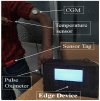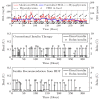Human Digital Twin for Personalized Elderly Type 2 Diabetes Management
- PMID: 36983097
- PMCID: PMC10056736
- DOI: 10.3390/jcm12062094
Human Digital Twin for Personalized Elderly Type 2 Diabetes Management
Abstract
Managing Elderly type 2 diabetes (E-T2D) is challenging due to geriatric conditions (e.g., co-morbidity, multiple drug intake, etc.), and personalization becomes paramount for precision medicine. This paper presents a human digital twin (HDT) framework to manage E-T2D that exploits various patient-specific data and builds a suite of models exploiting the data for prediction and management to personalize diabetes treatment in E-T2D patients. These models include mathematical and deep-learning ones that capture different patient aspects. Consequently, the HDT virtualizes the patient from different viewpoints using an HDT that mimics the patient and has interfaces to update the virtual models simultaneously from measurements. Using these models the HDT obtains deeper insights about the patient. Further, an adaptive patient model fusing this information and a learning-based model predictive control (LB-MPC) algorithm are proposed. The geriatric conditions are captured as model parameters and constraints while solving the LB-MPC to personalize the insulin infusion for E-T2D management. The HDT is deployed on and illustrated with 15 patients using clinical trials and simulations. Our results show that HDT helps improve the time-in-range from 3-75% to 86-97% and reduces insulin infusion by 14-29%.
Keywords: Elderly type 2 diabetes (E-T2D); digital twin (DT); human digital twin (HDT); internet of medical things (IoMT); learning-based model predictive control (LB-MPC); personalization; precision medicine.
Conflict of interest statement
The authors declare no conflict of interest.
Figures





























References
LinkOut - more resources
Full Text Sources

